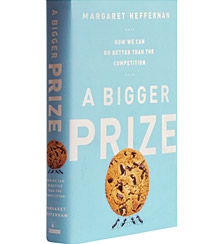The Downside of Competition
In A Bigger Prize, former CEO Margaret Heffernan argues that the corporate world has an unhealthy obsession with winning.
A Bigger Prize: How We Can Do Better Than the Competition
by Margaret Heffernan, PublicAffairs, 2014
Would you risk your own health if it guaranteed that you’d achieve the one big, hairy, audacious goal you’d aspired to all your life? Would you go so far as dying for it? In 1984, a researcher named Robert Goldman asked 198 elite athletes if they would take an undetectable drug that guaranteed them a gold medal and would also kill them within five years. Fifty-two percent said they would take it. The results held in tests repeated over the following decade. This has come to be known as the “Goldman dilemma.” We hold elite athletes in the highest esteem—as paragons of people at their physical and mental peak. But are we really celebrating an unhealthy obsession with winning?
In A Bigger Prize, Margaret Heffernan painstakingly examines the effects of competition among siblings and social groups, and in education, science, and business—and the result is a devastating indictment. Heffernan herself is no stranger to competition. She has been CEO of five different companies, including several riding the Internet boom years, and head of a trade association representing independent film and television producers in the United Kingdom. But instead of seeing greatness and achievement arising from the intense competition that drives so much of our world, Heffernan sees flaws, weaknesses, and vulnerabilities.
Modern science, in its struggle for scarce resources and pursuit of acclaim, offers a prime example. As Heffernan’s book shows, although scientists think of themselves as leaders and collaborators, they more often act like secretive soloists. So intense has the competition for recognition, funding, and glory become in the scientific community that the amount of research published in the most respected journals and subsequently retracted as rushed, faulty, or misleading has risen to record levels. As one academic tells Heffernan, for the younger generation of scientists, excessive competition is demoralizing, destructive, and counterproductive. Anxiety over the future, he says, is at an all-time high.
And for the rest of us, what are the consequences of a scientific community paralyzed by competition? What discoveries won’t be shared? What cures won’t be found?
Many of us have come to see Darwin’s “survival of the fittest” as a shorthand expression of the legitimacy of competition, but Heffernan has a thought-provoking counter-perspective: Natural selection is not synonymous with heightened competition. Researchers at Purdue University set out to determine whether the most productive chickens would breed a kind of super-chicken, spawning future generations of top producers. So they separated the best producers and left the rest to roam freely. What happened next was not a success story for the most productive chickens. Turned out that they tended to peck each other to death. Not only did some of them die, but the survivors actually became less productive over successive generations. By contrast, the free-range chickens became more productive over time.
Many see Darwin’s “survival of the fittest” as an expression of the legitimacy of competition.
In effect, the business world has attempted to reproduce this experiment, with similar results. Notable companies such as Microsoft and GE have divided their workforces into ranks—a human equivalent of the Purdue chicken experiment. But the puzzling failure of Microsoft to develop any truly innovative technologies over time has been attributed to “stack ranking,” the company’s version of forced ranking (it finally ended the practice in the fall of 2013). Top-notch developers did not want to work with other strong performers because doing so might risk their ranking. Even Jack Welch, with hindsight, has admitted that GE’s famous forced ranking system was a mistake. (Also see “Kill Your Performance Ratings,” by David Rock, Josh Davis, and Beth Jones.)
A Bigger Prize is well written, engaging, and deeply persuasive. Competitiveness does seem to be a real problem that threatens to stifle creativity, discovery, and joy in our lives and in our work. Yes, we are all inherently competitive, Heffernan concedes, but we’re not only competitive.
So what, then, does Heffernan say is a better way forward? Collaboration works, she assures us—providing the examples of companies (often privately held companies) where collaboration is truly sought and celebrated, such as W.L. Gore & Associates, maker of Gore-Tex fabrics; clothing manufacturer Eileen Fisher; and the Ocean Spray agricultural cooperative. Collaboration, Heffernan makes clear, is not synonymous with “going along to get along,” but rather is the product of healthy conflict, respect for others, and intellectual risk taking. Unfortunately, however, there are no simple universal principles that one can take away from the brief cases she offers. Heffernan admits that no blueprint exists for creating the ideal culture of collaboration. And although she finds easy examples of destructive competition throughout the business world, she’s hard-pressed to find an equal number of successful collaborative cultures.
In fact, Heffernan so thoroughly proves her thesis that competition is inherently destructive that it makes her prescriptive advice seem weak in comparison. A world in which cooperation is the standard, rather than the exception, is still an audacious goal, she suggests, but nevertheless a worthy one. As one of the world’s greatest leaders, Franklin Delano Roosevelt, once put it: “Cooperation, which is the thing we must strive for today, begins where competition leaves off.”![]()
Author profile:
- Karen Dillon has been editor of Harvard Business Review, deputy editor of Inc., and editor and publisher of The American Lawyer. She is coauthor, with Clayton M. Christensen and James Allworth, of How Will You Measure Your Life? (Harper Business, 2012) and author of HBR Guide to Office Politics (Harvard Business Press, 2013).





